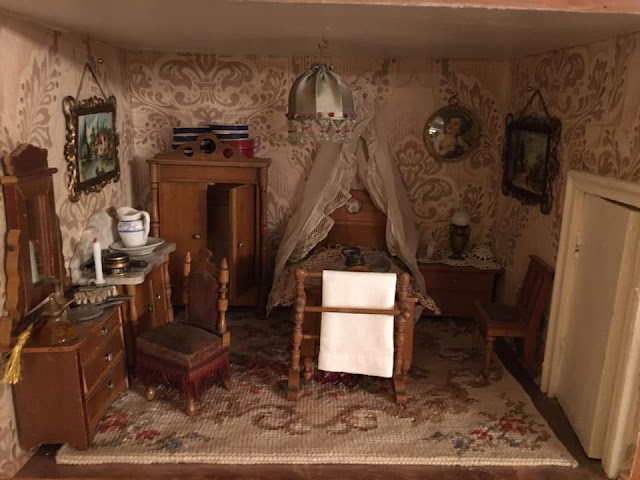I’m in such a blogging mood at the moment and today, I’ve got Gabriel Fourmaintraux on my mind!

That’s because I took delivery of these two sweet little vases which originated from his factory in Desvres - the coin is 2.3 cm (13/16”) tall, so the vases are the perfect size for a 1:16th scale dolls’ house.
Until I bough these, I was only aware of Gabriel Formaintraux from having seen a handful of his miniatures for sale on eBay at eye-watering prices.
However, the decoration on these vases is not typical of the Gabriel Formaintraux miniatures I’d seen previously, so when I saw them online for sale very cheaply, I certainly didn’t make the connection immediately.
But I did like them very much, so I browsed the seller’s photos and that’s when I saw the ‘GF’ maker’s mark on the bases and a lightbulb went on. A quick Google of the mark confirmed that my thinking was correct and my purchase was excitedly made!
I’ve put them on the mantelpiece in the dining room of my G & J Lines No. 17, where I think they look lovely.
Of course, the purchase made me want to know more about the maker, so I did some more Googling and I found a fascinating site, on the history of faïence (decorated tin-glazed earthenware) in Desvres by a lady whose grandfather worked in the Gabriel Fourmaintraux factory all his working life. He started as an apprentice in the factory in 1916, when he was just 13 years old and went on to become a talented ceramic artist there.
There are some great photos of the lady’s own collection of these miniatures on this page of her site. I was most interested to learn that these lovely little miniatures, often measuring less than a centimetre, were produced specifically for apprentices to train on, honing their decorative painting skills until they were ready to move on to the factory’s full-size pieces.
Finally, a few snippets, the first from Wikipedia:
The Fourmaintraux family’s ceramics business can trace its origins to when in 1804, François-Joseph Fourmaintraux, a former worker at Sta, founded his own factory.
And a few more from this site:
"Gabriel Fourmaintraux. Born 27 May 1886 in Desvres in the Pas de Calais region of Northern France to a family with a long history in the ceramics industry, Gabriel Fourmaintraux studied ceramics and began work in 1905 at the family factory, taking over the running of it in 1930. Production was extremely varied and ranged from lamps and utility items to advertising, trophies and tiles. Fourmaintreaux collaborated with Fernand Léger, a painter and potter who worked in Biot in the South of France. The association encouraged Fourmaintreaux to work in primary colours - reds, white, yellows on a black or white ground. It also encouraged him to produce items in various original shapes. Most of his work was made using moulds, his potted items being rare. The business finally closed in 1997."

INSERTED OCTOBER 2021: Since posting this blog, I've been lucky enough to find this lovely little Gabriel Fourmaintraux vase. It’s bigger than the vases shown above, but is still small enough to look good in a 1:12th scale dolls’ house. The maker’s mark on the base is shown below.

And to finish off, a couple of maker’s marks from full-sized pieces of Gabriel Fourmaintraux.
Until next time,
Zoe









































